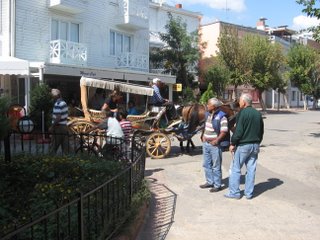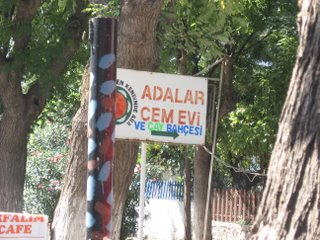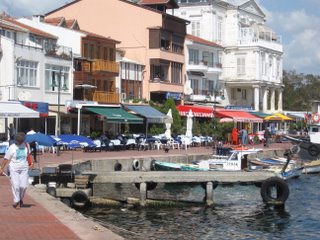Work took us on a one hour ferry ride to the Prince's Islands in the Sea of Marmara today. We have been there before: pristine old fashioned houses, clean beaches, quiet tea shops and restaurants, all because the bane of Istanbul existence - traffic - is absolutely banned from the islands. No cars. No taxis. No trucks. No traffic at all.

Horse cart taxis are the only form of transportation allowed.

The Islands serve as a holiday home refuge for the upper classes of Istanbul, but uniquely, they serve as the preserve of the Ottoman era minorities of Istanbul, i.e the Greeks, the Armenians and the Jews.
Buyukada is almost 100% Armenian.
Heibeliada is mostly Greek.
Burgazada, however, has a mixed population of all the groups, as well as Erzincan Turks who provide the workforce. No surprise that they are mostly
Alevi (non-orthodox, or properly heterodox sufi Muslims who don't believe in attending Mosque - they perform their ceremonies in a
Cem... more on Alevis later.)

Most importantly, Burgazada has a synagogue and supports the cream of the Sephardic crop of Istanbul's Jewish families who summer here. Actually, on weekdays, the majority of the population consists of grandmotherly types who spend the week planning huge dinners for the weekend. Basically, the meet during the week to discuss
who should marry who and plan the weekend's dinners accordingly. Then they get to
manipulate who marries who, which is the essence of Sephardic culture, after all. Have you listened to any of their music? It's all about the honor of the daughters, and let's face it, who is going to marry them that could cause a problem except for a bunch of us Ashkenazim... This is the social life on all of the Pince's Islands.
Who dines with who. On the Armenian islands, there aren't even any restaurants: if you want anything more than a doner kebab, you have to be invited into somebody's home to be evaluated for marriageability. At least on multi-ethnic Burgazada, there are a few seafront bistros, and of course, fish is kosher...

Sitting down for tea, I heard what seemed to be conversations in Spanish emanating fromt the Grandmas sitting around me. Dyed blonde hair, big designer sunglasses, the
Miami Beach works. But this sounded exactly like the Cuban Spanish I know from New York, not the lispy language spoken in Spain tody. It didn't drop the middle "s" like Cuban Spanish, but
damn, it sounded like upper class Mexicans or Cubans. Finally Fumie charmed our neighbors into a conversation and asked what languge they were speaking... they were a bit cagey at first, but they all spoke English and were friendly. "We were not speaking Turkish." Was it Ladino...
yes! There was lots of Turkish mixed in, the way English gets mixed into New York yiddish, lots of
tammams ("OK") and
evet ( " Yes") and Rosh Hashona was called a
bayram (Turkish/Arabic:
holiday : compare to
yiddish "yontif") but it was the same 15th century Castillian that the Cubans brought to the Caribbean and eventually to my NY area high school. A heck of a lot closer to Spanish than Yiddish is to German. Behold the largest gathering of Ladino speakers I ever saw outside of a linguistic conference .
Be fearful intheir presence. 
And over the next few hours the crowd grew from a quiet conversation into a geriatric babblefest of Ladino. When some of the younger women came up to them and spoke Turkish, the Grandmas didn't answer in Turkish, they spoke Ladino. Grandaughters replied in Turkish, and were again spoken to in Ladino. Burgazada is probably the last place where the Ladino language is still a
no compromise mode of street communication.

 Horse cart taxis are the only form of transportation allowed.
Horse cart taxis are the only form of transportation allowed.  The Islands serve as a holiday home refuge for the upper classes of Istanbul, but uniquely, they serve as the preserve of the Ottoman era minorities of Istanbul, i.e the Greeks, the Armenians and the Jews. Buyukada is almost 100% Armenian. Heibeliada is mostly Greek. Burgazada, however, has a mixed population of all the groups, as well as Erzincan Turks who provide the workforce. No surprise that they are mostly Alevi (non-orthodox, or properly heterodox sufi Muslims who don't believe in attending Mosque - they perform their ceremonies in a Cem... more on Alevis later.)
The Islands serve as a holiday home refuge for the upper classes of Istanbul, but uniquely, they serve as the preserve of the Ottoman era minorities of Istanbul, i.e the Greeks, the Armenians and the Jews. Buyukada is almost 100% Armenian. Heibeliada is mostly Greek. Burgazada, however, has a mixed population of all the groups, as well as Erzincan Turks who provide the workforce. No surprise that they are mostly Alevi (non-orthodox, or properly heterodox sufi Muslims who don't believe in attending Mosque - they perform their ceremonies in a Cem... more on Alevis later.)  Most importantly, Burgazada has a synagogue and supports the cream of the Sephardic crop of Istanbul's Jewish families who summer here. Actually, on weekdays, the majority of the population consists of grandmotherly types who spend the week planning huge dinners for the weekend. Basically, the meet during the week to discuss who should marry who and plan the weekend's dinners accordingly. Then they get to manipulate who marries who, which is the essence of Sephardic culture, after all. Have you listened to any of their music? It's all about the honor of the daughters, and let's face it, who is going to marry them that could cause a problem except for a bunch of us Ashkenazim... This is the social life on all of the Pince's Islands. Who dines with who. On the Armenian islands, there aren't even any restaurants: if you want anything more than a doner kebab, you have to be invited into somebody's home to be evaluated for marriageability. At least on multi-ethnic Burgazada, there are a few seafront bistros, and of course, fish is kosher...
Most importantly, Burgazada has a synagogue and supports the cream of the Sephardic crop of Istanbul's Jewish families who summer here. Actually, on weekdays, the majority of the population consists of grandmotherly types who spend the week planning huge dinners for the weekend. Basically, the meet during the week to discuss who should marry who and plan the weekend's dinners accordingly. Then they get to manipulate who marries who, which is the essence of Sephardic culture, after all. Have you listened to any of their music? It's all about the honor of the daughters, and let's face it, who is going to marry them that could cause a problem except for a bunch of us Ashkenazim... This is the social life on all of the Pince's Islands. Who dines with who. On the Armenian islands, there aren't even any restaurants: if you want anything more than a doner kebab, you have to be invited into somebody's home to be evaluated for marriageability. At least on multi-ethnic Burgazada, there are a few seafront bistros, and of course, fish is kosher...  Sitting down for tea, I heard what seemed to be conversations in Spanish emanating fromt the Grandmas sitting around me. Dyed blonde hair, big designer sunglasses, the Miami Beach works. But this sounded exactly like the Cuban Spanish I know from New York, not the lispy language spoken in Spain tody. It didn't drop the middle "s" like Cuban Spanish, but damn, it sounded like upper class Mexicans or Cubans. Finally Fumie charmed our neighbors into a conversation and asked what languge they were speaking... they were a bit cagey at first, but they all spoke English and were friendly. "We were not speaking Turkish." Was it Ladino... yes! There was lots of Turkish mixed in, the way English gets mixed into New York yiddish, lots of tammams ("OK") and evet ( " Yes") and Rosh Hashona was called a bayram (Turkish/Arabic: holiday : compare to yiddish "yontif") but it was the same 15th century Castillian that the Cubans brought to the Caribbean and eventually to my NY area high school. A heck of a lot closer to Spanish than Yiddish is to German. Behold the largest gathering of Ladino speakers I ever saw outside of a linguistic conference . Be fearful intheir presence.
Sitting down for tea, I heard what seemed to be conversations in Spanish emanating fromt the Grandmas sitting around me. Dyed blonde hair, big designer sunglasses, the Miami Beach works. But this sounded exactly like the Cuban Spanish I know from New York, not the lispy language spoken in Spain tody. It didn't drop the middle "s" like Cuban Spanish, but damn, it sounded like upper class Mexicans or Cubans. Finally Fumie charmed our neighbors into a conversation and asked what languge they were speaking... they were a bit cagey at first, but they all spoke English and were friendly. "We were not speaking Turkish." Was it Ladino... yes! There was lots of Turkish mixed in, the way English gets mixed into New York yiddish, lots of tammams ("OK") and evet ( " Yes") and Rosh Hashona was called a bayram (Turkish/Arabic: holiday : compare to yiddish "yontif") but it was the same 15th century Castillian that the Cubans brought to the Caribbean and eventually to my NY area high school. A heck of a lot closer to Spanish than Yiddish is to German. Behold the largest gathering of Ladino speakers I ever saw outside of a linguistic conference . Be fearful intheir presence.  And over the next few hours the crowd grew from a quiet conversation into a geriatric babblefest of Ladino. When some of the younger women came up to them and spoke Turkish, the Grandmas didn't answer in Turkish, they spoke Ladino. Grandaughters replied in Turkish, and were again spoken to in Ladino. Burgazada is probably the last place where the Ladino language is still a no compromise mode of street communication.
And over the next few hours the crowd grew from a quiet conversation into a geriatric babblefest of Ladino. When some of the younger women came up to them and spoke Turkish, the Grandmas didn't answer in Turkish, they spoke Ladino. Grandaughters replied in Turkish, and were again spoken to in Ladino. Burgazada is probably the last place where the Ladino language is still a no compromise mode of street communication.
2 comments:
Interesting story and post. I'd love to read more of your blog when I have more time.
Here's a great site in Ladino that I thought you might enjoy, being that you mentioned it in your story:
Ladino wiki browser
Post a Comment